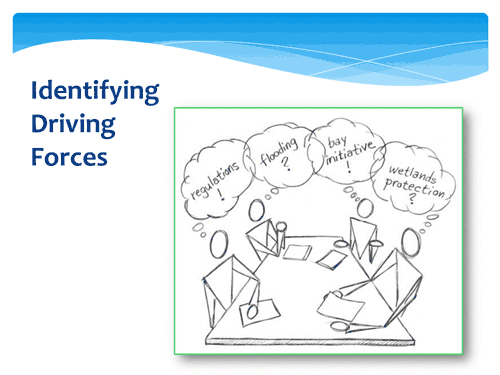Step 1: Build Partnerships (cont.)
Identify Driving ForcesWatershed plans can be initiated for various reasons and by various organizations. For example, a local agency might want to develop a watershed plan to comply with new federal and state water quality regulations. Or perhaps a watershed organization wants to develop a watershed plan to help coordinate future land use planning efforts to protect sensitive environmental areas in the community. It is important to identify the driving forces that are motivating you to develop a watershed plan. These driving forces will set the foundation for developing your plan’s goals and objectives. The typical watershed planning drivers usually fall into one of the following three categories.
Regulatory Issues
Water resource or other regulations sometimes require a planning or management document that contains some of or all of the elements required in a watershed plan. Communities pursuing efficient, effective approaches to planning often initiate a comprehensive watershed planning effort to streamline multiple planning tasks, such as meeting Clean Water Act section 303(d) requirements for development of total maximum daily loads (TMDLs), CWA section 319 grant requirements, or federal and state source water assessment and protection program regulations.
Government Initiatives
Dozens of federal, state, and local initiatives target geographic areas like the Chesapeake Bay or the Great Lakes, or attempt to focus on one aspect of a management program, such as the following:
- EPA-supported, geographically targeted programs (e.g., Chesapeake Bay programs, Great Lakes).
- U.S. Department of Agriculture (USDA) initiatives (e.g., Farm Bill programs, Forest Service planning).
- Other federal water resource initiatives (e.g., those sponsored by the Bureau of Land Management, the Bureau of Reclamation, and the National Oceanic and Atmospheric Administration).
- Stream or river restoration planning (e.g., by cities, counties, states).
- River authority and other state-enabled (or required) watershed planning initiatives.
- State initiatives such as Pennsylvania’s Growing Greener program or Michigan’s Clean Michigan Initiative.
Often the decision to develop a watershed plan comes from within the community. People have a desire to protect what they have or to restore water resources for future generations. Some compelling issues include flood prevention, development pressures, or a desire to protect drinking water sources.
![[logo] US EPA](https://www.epa.gov/epafiles/images/logo_epaseal.gif)






